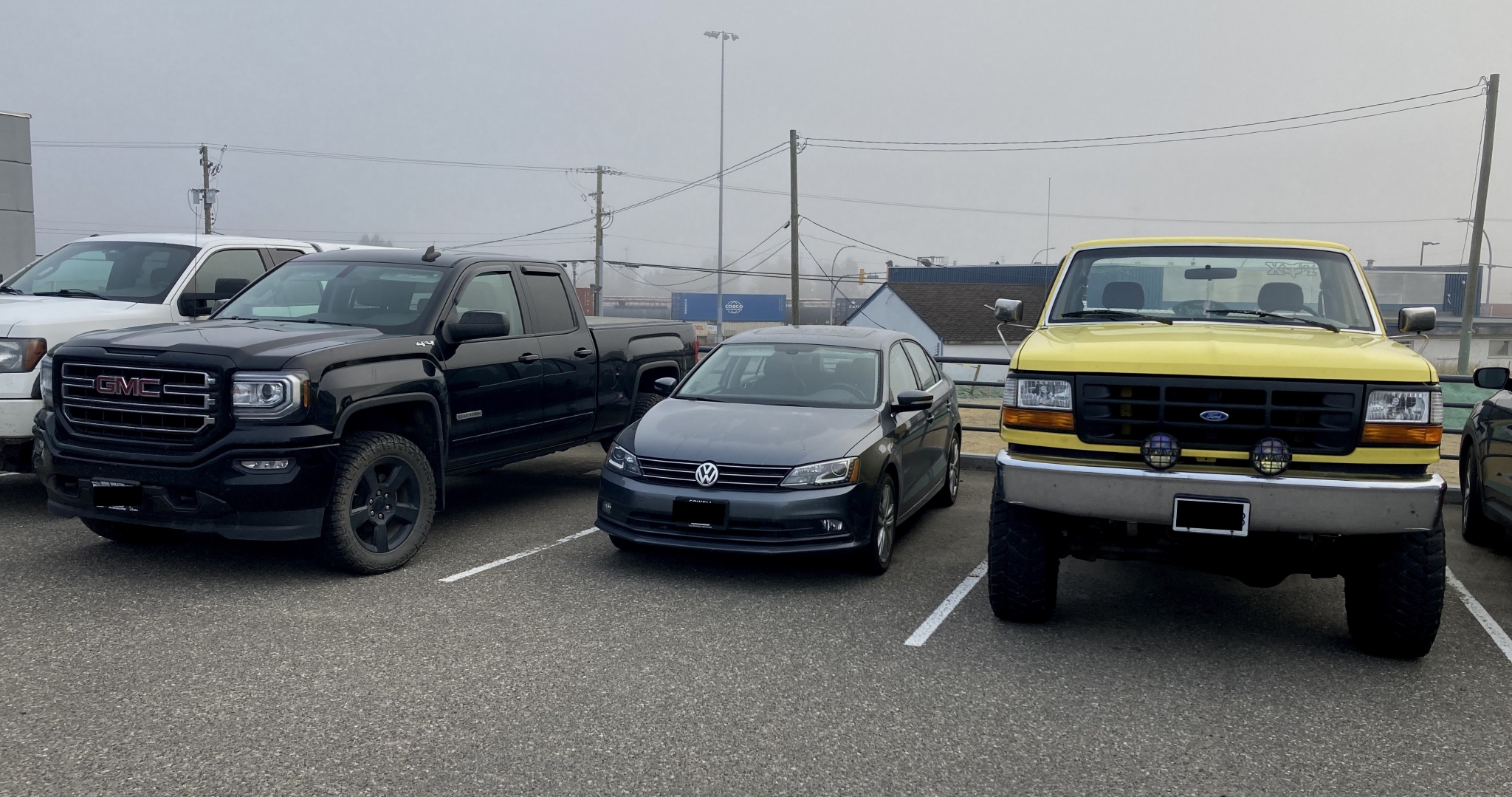The Lesser Spotted Sedan
 This week’s photo: the lesser spotted sedan in its natural habitat, parked among its much larger (and far more widespread) roadmates in Northern B.C.
This week’s photo: the lesser spotted sedan in its natural habitat, parked among its much larger (and far more widespread) roadmates in Northern B.C.
Driving in this city has become so annoying that I have effectively curtailed use of my vehicle to the bare minimum. My sedan’s tank is about 3/5 full and my budget app says the last time I filled up was February 11. Good. Box checked. (Disclosure: this is entirely due to a set of temporary circumstances which have afforded me the option of working from home.)
Burning less ancient bio-residue is certainly a win, and my primary concern remains the environment, but I will use this opportunity to talk about how unsafe the roads are in this ‘car city’. Drivers are not careful (just visit r/princegeorge and you will find plenty of anecdotes about erratic driving practices), conditions are often testing (the long winters can be rough), and the city is not at all walkable. Unlike other cities where pedestrian paths and safety are prioritized – say, clearing sidewalks of snow first – in PG, automated transportation always gets first dibs in council budgets. The unavoidable nuisance of driving is compounded by the fact that public transit is poor, the populace is unnecessarily spread out, and a certain, entitled NIMBYism prevents denser and more sensible, sustainable development.
Mostly, though, it is those damned trucks that make navigating the roads tiring. Everyone is rolling around in comically large vehicles. I get that this is an industry town where lots of people are engaged in outdoor sports, but it is representative of plenty of broader trends. (See here 1996’s Taken for a Ride, a foundational documentary which discusses some of the wider forces at play. Mainly: the car lobby’s successful efforts at fighting public transit, eco-conscious development, and regulations, at the cost of our general quality of life. Relevant to the entire North American context.)
For example, when I am up front taking a left at a major intersection, I can barely see behind the large trucks also waiting to turn in the opposite direction, effectively blocking the entire lanes behind them. I often need to inch forwards until I am almost into the opposing lane before I can confirm no oncoming traffic. Not ideal. Moreover, PG has a lot of randomly placed pedestrian crosswalks on streets like fifth avenue (busy during morning/evening commutes). If you are in a sedan with a truck slightly ahead, your view of anyone crossing, or looking to cross, is almost completely obscured. And in this city, if you dare slow down or drive with caution, you get honked at immediately. How dare you stick to the limit when the person behind is trying to go 80km/h in a 50 zone? Everyone has somewhere where they need to be right at that moment, it seems.
Then there is driving at night – the ridiculously bright LED headlights that inconveniently shine at my eye level, making it temporarily impossible to see anything. Even low beams on trucks and SUVs are dangerously positioned. Add to any of these circumstances rain, slush, snow, or even haze, and you can paint a picture of a world where there are ticking time bombs in each direction in the form of massive vehicles.
From the Fall of 2017 to the end of 2024, I had to travel significant distances by car. Often the more prudent or economical option (in time and money) given supplies being carried and the difficulty of flying between small towns and remote Indigenous communities across B.C. Including many a day trip ranging from 7 to 11 hours long, traversing paved highways, winding dirt roads, gravel lanes, and occasionally backroad infrastructure mostly used by logging companies. Throughout those years, I was regularly required to drive moderate to large SUVs – a Chevy Suburban, a couple of Toyota 4Runners, and a few different Ford models (Explorer, Plex, and Edge). These lumbering vehicles always frustrated me; they had noticeable blind spots, required far more fueling, and generally demanded more diligence.
These vehicles are the norm in PG and across rural communities in the province. As noted in the video above, this is a recent trend. And it will continue. The car companies’ marketing has won, and they will continue to push heavier, less practical options for greater profit. As a consumer, it is so much easier to buy larger vehicles now and not feel anything untoward. You also probably feel safer, sitting in a machine of similar size to others on the road – the bigger and bulkier your exoskeleton, the less you will have to worry in the event of a crash, right? But I cannot personally abide by this rationale, because it means more dangerous roads for everyone.
That is where we have come to, though. Dinosaurs running on dinosaurs; our whole society hooked on demonstrably belligerent behemoths.
I will keep chugging along in my smaller car, avoiding driving at night or in difficult weather as much as I can. My only recourse as I cannot tolerate abandoning this endangered North American species.